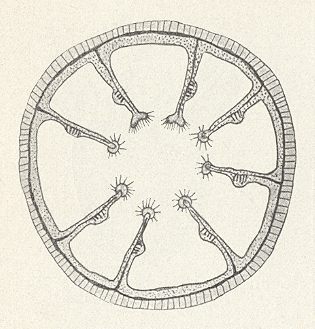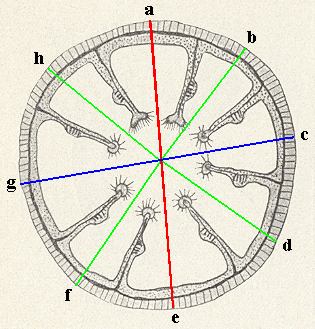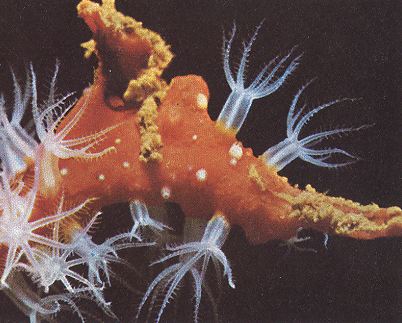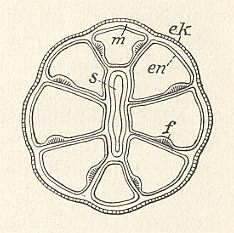
The Octocorallia or Alcyonaria all have definitely eight antimers. If we limit our consideration to the skeleton only, then the eight antimers are congruent and then the stereometric basic form is that of the Isopola octactinota. If, in addition to the skeleton, we also take into account the soft parts of the polyp then a very slight deviation from the octactinote plan is visible causing the basic form to belong to the Allopola octamphipleura, as the next Figure shows.

To see the inclination towards the Allopola octamphipleura, see the next Figure. The overall slight irregularity (of the general outline of the animal) as is visible in this and the previous Figure, is extrinsic, and falls outside the promorphological consideration. The irregularity of the arrangement of the soft parts along the sides and apex of the (skeletal part of the) septa is constant and thus intrinsic, and represents the inclination towards the octamphipleural form.

Figure 2. Arrrangement of septa in Octocorallia (cross section), as taken from the previous Figure. If we take the configuration of the soft parts into consideration, then the only mirror plane possessed by the coral is the line a-e. The line g-c does not represent a mirror plane. This line, and the line a-e represent the directional axes. There are (still) eight antimers, indicated respectively by a-b, b-c, c-d, d-e, e-f, f-g, g-h, h-a. Thus as such the basic form of the body belongs to the Allopola octamphipleura.

Figure 3. Red Coral, Corallium rubrum, Octocorallia, Anthozoa.
The individual polypes are visible, associated with the red skeleton of the colony.
( After KILIAS, R., 1971, in Neue grosse Tier-enzyklopädie )

Figure 4. Transverse section through an octocorallium (Alcyonium).
The septa of one side are exactly symmetrically ordered to those of the other side, and all of them bearing the "muscle flags" on the same side (i.e. on the dorsal side of each septum). ek, ectoderm. en, entoderm. s, gullet. m, intermediate lamella.
( After HERTWIG, R., 1907, Lehrbuch der Zoologie )
In all Anthozoa (corals, sea-anemones, octocorallia (gorgonians, sea-pens)), the mouth is not just a simple aperture of the gastral cavity, but runs into the stomach by an ectodermal gullet, which is in all forms flattened transversely. In Figure 4 we see this flattened gullet in the case of an octocorallium. The shape of this gullet and the relative extensions of the septa clearly determine a bilateral symmetry. This is even enhanced by the emplacement of the muscle flags : While we see a mirror plane along the longer dimension of the section of the gullet, a mirror plane perpendicular to this is absent, because of these muscle flags. So the basic form of the coral, strictly is such as belonging to the Allopola octamphipleura (as we had already established earlier), it approaches however that of the (Autopola) Oxystaura octophragma. When we ignore the features of these soft parts, and concentrate on the skeleton and on the eight-fold tentacle ring, we can evaluate these corals as Isopola octactinota anyway.